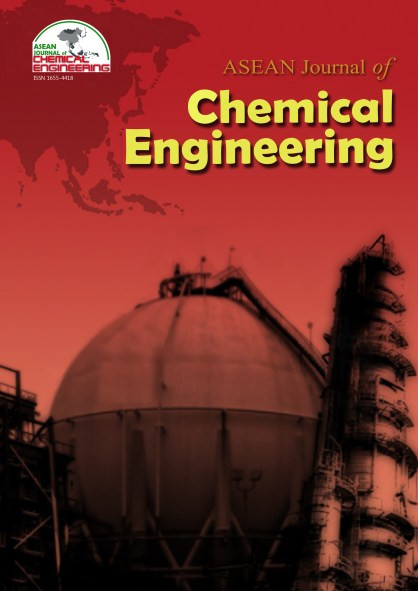Anionic Dye Adsorption from Aqueous Solutions by Chitosan Coated Luffa Fibers
Abstract
Chitosan (CS) is biopolymer derived from deacetylation of chitin which can be found mainly in crustacean shells such as shrimp, crab, lobster etc. CS powder has been used to remove dye in many research. However, it was difficult to separate CS powder from aqueous solution. Considering the three-dimensional sponge natural structure of luffa fiber. it may address this issue by coating CS onto the surface of luffa fiber. This adsorbent was called chitosan coated luffa fiber (CS-LF). The aim of this studied is to investigate the potential of CS-LF to remove the anionic dye. Congo red is representative of anionic dye. Adsorption of anionic dye from aqueous solution using CS-LF was studied in a batch system. The effect of chitosan concentration coated on luffa fiber and initial anionic dye concentrations had been investigated on adsorption equilibrium and adsorption kinetic. An adsorption isotherm data were regularly analyzed using Langmuir and Freundlich isotherm models. While, adsorption kinetic were basically evaluated by pseudo-first-order, pseudo-second-order and intraparticle diffusion equation. The results showed that the adsorption isotherm fitted well by Langmuir isotherm model with maximum adsorption capacity 20.37 mg/g. The anionic dye adsorption kinetic of CS-LF were greatest described by pseudo-second-order equation and rate-controlling step of anionic dye adsorption process may be chemical reaction. Therefore, CS-LF is potential adsorbent as low-cost adsorbent to remove anionic dye from aqueous solution and could be simply separated from aqueous solutions after used. Finally, our study is firstly report in anionic dye adsorption using chitosan coated luffa fiber.
References
2. S. Wong, N.A.N. Yac’cob, N. Ngadi, O. Hassan, I.M. Inuwa, From Pollutant to Solution of Wastewater Pollution: Synthesis of Activated Carbon from Textile Sludge for Dyes Adsorption, Chinese J. Chem. Eng. (2017).(to be published)
3. S.S. Salih, T.K. Ghosh, Adsorption of Zn(II) ions by chitosan coated diatomaceous earth, Int. J. Biol. Macromol. (2017). (to be published)
4. M. Ferhat, S. Kadouche, N. Drouiche, K. Messaoudi, B. Messaoudi, H. Lounici, Competitive adsorption of toxic metals on bentonite and use of chitosan as flocculent coagulant to speed up the settling of generated clay suspensions, Chemosphere. 165, 87–93 (2016).
5. J. Xie, C. Li, L. Chi, D. Wu, Chitosan modified zeolite as a versatile adsorbent for the removal of different pollutants from water,Fuel. 103, 480–485. (2013)
6. J.Y. Farah, N.S. El-Gendy, L.A. Farahat, Biosorption of Astrazone Blue basic dye from an aqueous solution using dried biomass of Baker’s yeast, J. Hazard. Mater. 148(2007) 402–408.
7. G.Z. Kyzas, K.A. Matis, Nanoadsorbents for pollutants removal: A review, J. Mol. Liq. 203, 159–168 (2015)
8. Kinetics, isotherms and thermodynamic modeling of liquid phase adsorption of Rhodamine B dye onto Raphia hookerie fruit epicarp, Water Resour. Ind. 15, 14–27 (2016).
9. Y.C. Wong, Y.S. Szeto, W.H. Cheung, G. McKay, Equilibrium studies for acid dye adsorption onto chitosan, Langmuir. 19, 7888–7894 (2003)
10. T.W. Weber, R.K. Chakravorti, Pore and solid diffusion models for fixed???bed adsorbers, AIChE J. 20, 228–238 (1974)
11. B. Liao, W. Sun, N. Guo, S. Ding, S. Su, Equilibriums and kinetics studies for adsorption of Ni(II) ion on chitosan and its triethylenetetramine derivative, Colloids Surfaces A Physicochem. Eng. Asp. 501, 32–41(2016)
12. X. Tang, Q. Zhang, Z. Liu, K. Pan, Y. Dong, Y. Li, Removal of Cu(II) by loofah fibers as a natural and low-cost adsorbent from aqueous solutions,J. Mol. Liq. 199, 401–407 (2014).
13. F. Rozada, Dye adsorption by sewage sludge-based activated carbons in batch and fixed-bed systems, Bioresour. Technol. 87, 221–230. (2003)
Copyright holder for articles is ASEAN Journal of Chemical Engineering. Articles published in ASEAN J. Chem. Eng. are distributed under a Creative Commons Attribution-NonCommercial 4.0 International (CC BY-NC 4.0) license.
Authors agree to transfer all copyright rights in and to the above work to the ASEAN Journal of Chemical Engineering Editorial Board so that the Editorial Board shall have the right to publish the work for non-profit use in any media or form. In return, authors retain: (1) all proprietary rights other than copyright; (2) re-use of all or part of the above paper in their other work; (3) right to reproduce or authorize others to reproduce the above paper for authors’ personal use or for company use if the source and the journal copyright notice is indicated, and if the reproduction is not made for the purpose of sale.



